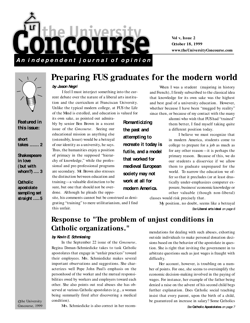What matters the identity or the sexual orientation of ‘Shakespeare’?
by Joanna K. M. Bratten
I want to thank Mr. Englert for expending the time and energy involved in addressing the main point of the Shakespeare question in his article in the September 22 issue of the Concourse. Had I, as a card-carrying “Stratfordian,” taken the time to review Sobran’s arguments and present an argument against them, I think I would have come up with a similar response. Yet there is something more to be added to the discussion; perhaps I am merely pursuing quibbles, a practice for which Dr. Johnson chided the Bard himself (whoever he may be). I would like, however, to consider several passings comments made by Katie van Schaijik when she first posed the question “who was Shakespeare?” way back in April of 1998.
The comments to which I refer pertain to the unsatisfactory nature of Shakespeare’s sonnets (as opposed to those of Elizabeth Barrett Browning for example) and the homoerotic undertones of the first portion of the sonnet sequence. Mrs. van Schaijik writes, first of all, that, according to Sobran, the general public has been unwilling to acknowledge the Earl of Oxford as the author of the works allegedly written by Shakespeare in part because of an “unwillingness to admit the likelihood that the greatest sonnets in the English language were inspired by a homosexual passion.”
The Earl of Oxford, of course, was known to be of homosexual inclinations, in whatever sense this term meant to Elizabethan society.1 Mrs. van Schaijik writes further that
[T]he sonnets . . . have been disappointing. More than once, looking for inspiration, or for help in expressing some elusive aspect of the mystery of conjugal love, I have turned to his sonnets, and come away virtually empty-handed (feeling, I might add, a little confused and conflicted about it. Was I missing something? This was Shakespeare.)
The final comment of the article I admit I found confusing, at the time I first read it and even now as I am re-reading it. Mrs. van Schaijik states that ‘. . . a Christian need not be depressed or scandalized if it turns out to be true that [the Sonnets] were inspired mainly by a disordered, same-sex passion.’
Perhaps it is best to address the comments in order of appearance. The homosexuality of the Earl of Oxford may or may not have not deterred critics and readers from embracing the Oxfordian theory of authorship. As Mr. Englert noted in his article, the question of authorship, particularly in recent critical circles, is not one taken terribly seriously.
Most of us who have to write about literature for a living would admit that at the end of the day it really doesn’t matter whether Shakespeare wrote the plays and sonnets, or whether he was a homosexual, bisexual or heterosexual, or whether he was from Stratford, Oxford or Berwick-upon-Tweed. What we have to work with are the texts, and anything we infer from them about their author is mere speculation. But, since literary criticism does depend largely on speculation for its livelihood, inferences are inevitable.
But on to the meatier matter. Mrs. van Schaijik claims that she finds the Sonnets disappointing. I would argue that if a reader finds the Sonnets disappointing then he or she is looking for something in them that is simply not meant to be there. In this case, the reader has claimed to have sought elucidation on the mysteries of conjugal love. I can argue two different positions here, both with which I agree.
On one hand, the Sonnets are not “about” conjugal love. The first, larger, portion of the Sonnets is devoted to the “fair youth;” some might consider this portion homoerotic in tone and content but I would argue, rather, that far from expressing homoeroticism the poems express male friendship in a manner largely extinct since the seventeenth century:
Let me not to the marriage of true minds
Admit impediments; love is not love
Which alters when it alteration finds,
Or bends with the remover to remove.
O, no, it is an ever-fixed mark
That looks on tempests and is never shaken;
It is the star to every wand’ring bark,
Whose worth’s unknown, although his height be taken.
Love’s not Time’s fool, though rosy lips and cheeks
Within his bending sickle’s compass come;
Love alters not with his brief hours and weeks,
But bears it out even to the edge of doom.
If this be error and upon me proved,
I never writ, nor no man ever loved.
The second, smaller, portion is devoted to the “dark lady,” expressing explicit sexual love, perhaps extramarital, but a love, it seems, quite “on in years,” realistic and mature, to say the least. Of note is the way in which Shakespeare deconstructs the classic love sonnet and the stereotypical romantic metaphors:
My mistress’ eyes are nothing like the sun;
Coral is far more red than her lips’ red;
If snow be white, why then her breasts are dun;
If hairs be wires, black wires grow upon her head.
I have seen roses damask’d, red and white,
But no such roses see I in her cheeks;
And in some perfumes is there more delight
Than in the breath that from my mistress reeks.
I love to hear her speak, yet well I know
That music hath a far more pleasing sound:
I grant I never saw a goddess go,—
My mistress, when she walks, treads on the ground:
And yet, by heaven, I think my love as rare
As any she belied with false compare.
On the other hand, I would argue that the Sonnets are “about” conjugal love. The love between the poet and the fair youth mirrors in itself the young, early love of marriage, yet concerned with age and time:
That time of year thou mayst in me behold
When yellow leaves, or none, or few, do hang
Upon those boughs which shake against the cold,
Bare ruin’d choirs, where late the sweet birds sang.
In me thou see’st the twilight of such day
As after sunset fadeth in the west;
Which by and by black night doth take away,
Death’s second self, that seals up all in rest.
In me thou see’st the glowing of such fire,
That on the ashes of his youth doth lie,
As the death-bed whereon it must expire
Consum’d with that which it was nourish’d by.
This thou perceiv’st, which makes thy love more strong,
To love that well which thou must leave ere long.
The love between the poet and his dark lady contains within itself the deeper and more difficult, mutually compromising, love of marriage; as with the previous sonnet from the dark lady portion, Shakespeare’s writing is earthy, ironic:
When my love swears that she is made of truth
I do believe her, though I know she lies,
That she might think me some untutor’d youth,
Unlearned in the world’s false subtleties.
Thus vainly thinking that she thinks me young,
Although she knows my days are past the best,
Simply I credit her false-speaking tongue:
On both sides thus is simple truth supprest.
But wherefore says she not she is unjust?
And wherefore say not I that I am old?
O! love’s best habit is in seeming trust,
And age in love loves not to have years told:
Therefore I lie with her, and she with me,
And in our faults by lies we flatter’d be.
While the Sonnets are certainly not optimistic, neither are they pessimistic. Collectively they overturn stale conventions of romantic verse and present an un-romanticized (or as current theorists would say, a de-mythified) portayal of the vicissitudes of love; clearly the Sonnets present a form of balance, regardless of who wrote them and of the poet’s sexual orientation. This is why I confess confusion over Mrs. van Schaijik’s final remark, that a Christian need not be “depressed” or “scandalized” should it be discovered that the Sonnets were written by a homosexual. Surely Christians are not obliged to judge art entirely on the personal lives of the artist. I am not suggesting that Mrs. van Schaijik meant to imply this, yet this is the implication that comes across from her statement. Certainly, we do not find Plato’s Symposium scandalous, yet are fully aware of the fact that the love being praised in the discussion is what we might call a “disordered same-sex passion.” Even the most conscientious reader of the Symposium or the Sonnets should be able to find beauty and truth in both of these works, without being prejudiced by knowing that homosexual love might be lurking somewhere in the background.
W.H. Auden, another writer whose personal life and sexual preference may cause certain readers to find his work less-than agreeable, wrote the following of Shakespeare in relation to his Sonnets, which seems to me to sum up the authorship question nicely:
It should be borne in mind that the most genuine artists prefer that no biography be written. A genuine artist believes he has been put on earth to fulfil a certain function determined by the talent with which he has been intrusted. His personal life, naturally, is of concern to himself and, he hopes, to his personal friends, but he does not think it is or ought to be of any concernto the public. The one thing a writer hopes for. . . is attentive readers of his writings.2
While I persist in fondly believing that the writer of the Sonnets was William Shakespeare of Stratford-upon-Avon, there remains one concrete fact which I will affirm: regardless of the name of the writer of the Sonnets, or his sexual preference, the Sonnets can be judged on their own merits alone, as encompassing the breadth, depth and width of the human experience of love and all it entails. The quest to discover the “real” Shakespeare seems to me not merely a waste of time (since no one will ever know) but an unnecessary invasion into the mysterious anonymity of the poet. Need a poet’s life be stripped open before his readers? Auden thought not, and Browning would concur: “Shall I sonnet-sing you about myself? . . . Did Shakespeare? If so, the less Shakespeare he!”3
Joanna Bratten (‘97) is a candidate for a PhD in English at the University of St Andrews in Scottland.
- This is certainly not to say that the practice of “homosexuality” as such differs in our time from that of the Elizabethans; nevertheless, in the “Elizabethan world picture,” to employ Tillyard’s deplorably general but useful term, homoerotic love, and its relation to heterosexual love, presented itself quite differently than it does to our own “world picture.” I do not wish to exhaust unnecessary words proving what is a generally accepted position, but those who are interested in the Elizabethan attitude to homoeroticism and related issues can refer to Jonathan Goldberg’s book Sodometries: Rensaissance Texts, Modern Sexualities (Stanford University Press, 1992) or Premodern Sexualities edited by Louise Fradenburg and Carla Freccero (Routledge, 1996). ↑
- W.H. Auden. Introduction to the Sonnets in the Signet Classic Shakespeare, general editor Sylvan Barnet (Harcourt Brace, 1963). ↑
- Robert Browning, “House” ↑


